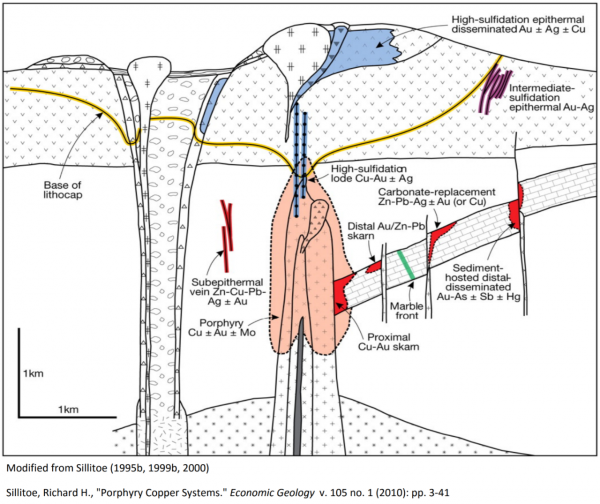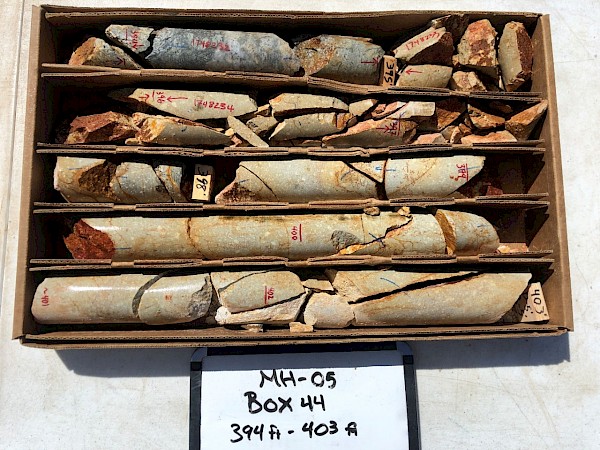Kingman Examines Indicators For Larger Porphyry System & Looks Ahead To Phase II Drilling Program
Vancouver, B.C. (April 16, 2021) Kingman Minerals Ltd. (“Kingman” or the “Company”) (TSX.V: KGS, FSE: 47A1) is pleased to announce the completion of the Phase I Drilling Program and report the receipt of assays for borehole MH-05. The Phase I Drilling Program completed a total 2552.5 feet (778 meters) of diamond core drilling which provides a fresh catalog of modern drill core for data collection and a significant and increased understanding of the geological, alteration, and structural controls at the Mohave Gold Project.
System Indicators & Exploration
Initially expected to exclusively occur as strongly oxidized veins along the upper and lower contacts of the rhyolite intrusions, returned assay results from the Phase I Drilling Program have definitively demonstrated that gold and silver concentrations are directly associated with one or a combination of up to four key and readily observable geological indicators including:
- Overall proximity to rhyolite intrusions;
- Presence of iron-oxide mineralization;
- Relatively intense hydrothermal clay alteration;
- Presence of sulfide-bearing hydrothermal breccias;
“These findings coupled with the extent of hydrothermal alteration are very intriguing as these are indicators we look for not only in epithermal gold environments but those of larger deposit footprints such as porphyry base-metal systems which often exist in genetic relationship to vein deposits such as those seen at the Mohave Gold Project.” commented Christopher Seligman, B.Sc., MAusIMM CP(Geo), Senior Geologist with Dahrouge Geological Consulting USA Ltd. of Denver, Colorado and Qualified Person as defined by National Instrument 43-101 who supervised technical activities during the Phase I Drill Program.

Figure 1 – Porphyry-type mineral deposits are formed from large amounts of hot water sourced that originates from large magma chambers in the Earth and are often related to numerous other metal deposits and styles including epithermal gold-silver deposits.
With the Phase I Drilling Program completed, received assay results will continue to be validated and incorporated into the geological and structural models for the Mohave Gold Project in support of the planned resource estimate for the Mohave Gold Project. Additionally, the extensive amount of diamond drilling data collected during the Phase I Drilling Program will also continue to be incorporated into exploration models to guide the anticipated Phase II Drilling Program.
“The confirmation and verification of historically reported assay grades coupled with the latest geological observations will be invaluable towards the update and refinement of the deposit model in support of further exploration and delineation efforts,” commented Christopher Seligman.
The Phase I Drilling Program consisted of five confirmation drill holes to verify both the nature and the grades of historic mineralization performed at the previously producing and property-inclusive Rosebud Mine and will allow the Company to produce a current NI-43 101 technical report and resource estimate for the mine area.
MH-05 Borehole Summary:
Borehole MH-05 was drilled at an angle of -60 degrees to horizontal to pass through the two target mineralized veins and completed at a depth of 449.5 feet (137 meters) with the following highlights:
- Collared into a broad zone of hydrothermal alteration consistent with epithermal deposits;
- Intersected continuous zone of strong iron-oxide from 380.5 – 394.5 feet (116 – 120 meters);
- Intersected hydrothermal sulfide-breccia from 394 – 395 feet (120 – 120.5 meters);
- Encountered impassable void at 449.5 feet (137 meters) before intersecting second target vein;
“Although we were not able to intersect the second vein, the presence of the underground void where it was located is encouraging as it is in line with where we projected the second vein to occur and suggests the likely previous presence of mineable mineralized material during the Rosebud Mine operation,” commented Brad Peek, M.Sc. CPG and Qualified Person for the Mohave Project.
MH-05 Assay Highlights:
- 6.0 g/t Au over 4 feet (1.2 meters) from 391-395 feet within diorite and diabase and
26.2 g/t Ag (1.6 feet true width); - 23.3 g/t Au over 1 feet (0.3 meters) from 394-395 feet within diabase sulfide-breccia and
41.4 g/t Ag (0.4 feet true width);
|
MH-05 ASSAY RESULTS |
|||||||||
|---|---|---|---|---|---|---|---|---|---|
|
Au |
Au |
Ag |
Ag |
||||||
|
ppm |
g/Mt |
ppm |
g/Mt |
||||||
|
0.005 |
0.03 |
0.1 |
3 |
||||||
|
C/N |
ROCK TYPE |
COMMENTS |
FROM (FT) |
TO (FT) |
SAMPLE ID |
FA-01 |
FA-03 |
FA-08 |
FA-03 |
|
1 |
DIORITE |
Strong FeOx |
188 |
189 |
1748224 |
0.074 |
1.8 |
||
|
2 |
DIABASE |
Intense FeOx |
189 |
190 |
1748225 |
0.649 |
3.6 |
||
|
3 |
DIABASE |
Subtle FeOx |
329.5 |
330.5 |
1748226 |
0.02 |
1.3 |
||
|
4 |
DIORITE |
Strong FeOx |
380.5 |
381.5 |
1748227 |
0.085 |
1.1 |
||
|
5 |
DIORITE |
Weak FeOx |
381.5 |
382.5 |
1748228 |
0.008 |
0.3 |
||
|
6 |
DIABASE |
Moderate FeOx |
391 |
392 |
1748229 |
0.022 |
3.7 |
||
|
7 |
DIABASE |
Strong FeOx |
392 |
393 |
1748230 |
0.164 |
33.9 |
||
|
8 |
DIABASE |
Strong FeOx |
393 |
394 |
1748231 |
0.362 |
26.1 |
||
|
9 |
DIABASE |
Sulfide Breccia |
394 |
395 |
1748232 |
> 5.000 |
23.3 |
41.4 |
|
|
10 |
RHYOLITE |
Moderate FeOx |
395 |
396 |
1748233 |
0.016 |
0.1 |
||
|
11 |
RHYOLITE |
Weak FeOx |
396 |
397 |
1748234 |
0.029 |
0.4 |
||
Figure 2 – Summary of assay results from borehole MH-05
The highest assay results from borehole MH-05 were focused within the intersected hydrothermal sulfide-breccia starting at 394 feet (120 meters) which was characterized by very little iron oxidation which suggests that the sulfides are likely carrying the gold mineralization.

Figure 3: Sulfide breccia in sample 1748232 which returned 23.3 g/t Au and 41.4 g/t Ag
“These additional and final assay results are very compelling as we have now confirmed both the target and grades for which the Rosebud Mine operated. We can now focus on these results and latest observations to improve our geological context and exploration targeting to determine the extent and potential of the Mohave Gold Project both laterally and at depth,” commented Brad Peek.
Analysis:
Samples were sent to Skyline Assayers & Laboratories located in Tucson, AZ on a rush basis for gold and silver analysis which were completed using Skyline’s FA-1 method for gold (Fire Assay– AA Geochem 5-5,000 ppb, 30g, with gravimetric finish for over-limits) and FA-8 for silver (Aqua Regia/AA Geochem).
Technical Information & Quality Control Notes:
The technical information contained in this news release has been reviewed and approved by Brad Peek., M.Sc., CPG, who is a Qualified Person with respect to Kingman Minerals Ltd. and the Mohave Project as defined under National Instrument 43-101.
About Kingman
Kingman Minerals Ltd. is currently engaged in the business of precious metal mineral exploration for the purpose of acquiring and advancing non grass roots mineral properties located in mining friendly jurisdictions of North America.
The Mohave Project (the “Project”) is located in the Music Mountains in Mohave County, Arizona and is comprised of 71 lode claims which are inclusive of the past producing Rosebud Mine (the “Rosebud”). High grade gold and silver veins were discovered in the area in the 1880’s and were mined mainly in the late 20’s and 30’s. Underground development on the Rosebud property included a 400-foot shaft and approximately 2,500 feet of drifts, raises and crosscuts.
For further information please contact:
Sandy MacDougall, Chairman & Director
(604) 685-7720
moc.slarenimnamgnik@llaguodcams
www.kingmanminerals.com
Neither the TSX Venture Exchange nor its Regulation Services Provider (as that term is defined in the policies of the TSX Venture Exchange) accepts responsibility for the adequacy or accuracy of this release. This news release may contain forward-looking information which is not comprised of historical facts. Forward-looking information involves risks, uncertainties and other factors that could cause actual events, results, performance, prospects and opportunities to differ materially from those expressed or implied by such forward-looking information. Forward-looking information in this news release includes statements regarding, among other things, the completion transactions completed in the Agreement. Factors that could cause actual results to differ materially from such forward-looking information include, but are not limited to, regulatory approval processes. Although Kingman believes that the assumptions used in preparing the forward-looking information in this news release are reasonable, including that all necessary regulatory approvals will be obtained in a timely manner, undue reliance should not be placed on such information, which only applies as of the date of this news release, and no assurance can be given that such events will occur in the disclosed time frames or at all. Kingman disclaims any intention or obligation to update or revise any forward-looking information, whether as a result of new information, future events or otherwise, other than as required by applicable securities laws.
